5 Colonial Religion, or, The Belief in Separation of Church and State (until recently)
Colonial Religion
Jim Ross-Nazzal, PhD and Students
This chapter is both a condensed version of and extrapolated from my lecture inspired by https://www.worldhistory.biz/modern-history/82863-religion-and-early-american-history.html
Legacies
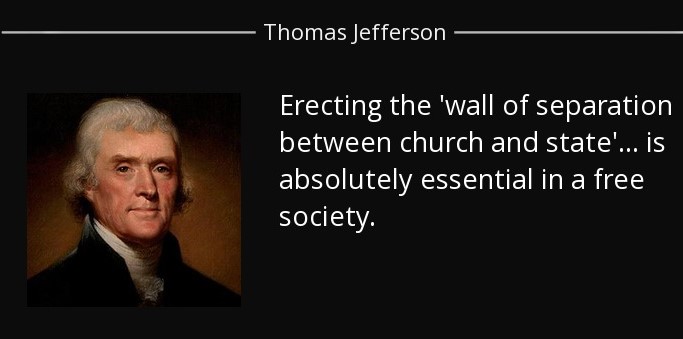
The Crusades did two things. First, they demonstrated exploration, contact, and trade. Second, they resulted in religious warfare that lasted hundreds of years. From the first crusade called by Pope Urban II in 1099, there were crusades against Muslims to retake Jerusalem (all failed) and there were internal crusades to rid western Europe of Jews. While the Crusades may have provided the oldest base or legacy of exploration for those who first came to North America, those who settled along the eastern seaboard also were aware of this example of religious conflict, something they wished to avoid.
The Protestant Reformation started off simply enough as one of representation in Rome that quickly involved the hundreds of principalities that made up what is today Germany. As one principality after another broke away from Rome and declared their religious independence, eventually the English monarch, Henry VII, sent in troops to compel the rebels to return to the Catholic Church earning him the title Defender of the Faith. But soon even Henry broke away. Soon there was no such thing as the Protestant religion as there were dozens upon dozens of Protestant sects, each with their own leaders who spoke of their own truth to salvation. Not only was there religious warfare between Catholics and Protestants (such as in France) but this massive schism in Protestantism resulted in religious warfare among Protestants.
In England, there were many who saw Henry’s views on religion inaccurate or intolerable, Some thought they could work with the established church to fix the ills of Anglicanism while others saw Anglicanism as antithetical to their own salvation. Many groups who settled in the British colonies fell into the latter group, such as the Puritans. Massachusetts became a colony fr puritans (Catholics, Quakers, and Unitarians were prohibited from settling there) while Anglicans settled n the first colony, Virginia, which also prohibited the settlement of Catholics. From the beginning, religious tensions were there.
However, as Max Weber (who also made a fine grill) pointed out, the Puritan work ethic promoted a government divorced from religious influence. In the North, the government tended to take place at the local level. Yes, there existed the colonial governor and a colonial legislature but those tended to take care of Big Picture stuff. Deciding to build a new court house, a bridge, a schoolhouse, were decisions left to local, town governments in the North. In the South, “where the Anglican church was dominant, was the basic structure of church rule and therefore also political rule.”[1] But the colonial legacy of government was that of the local, town hall meetings of the Puritans from Massachusetts and they were separated from the established churches. Weber also noted that America was economically successful because the Puritan work ethic, very simply put, was the basis of capitalism. Thomas Jefferson was a proponent of government at the local level: Jeffersonianism, then later the Democratic party, was based on this idea.
I cannot overemphasize how the religious wars and conflicts in England, resulted in colonists not wanting to repeat that and so they avoided the injection of religion into their politics. Separation of church and state. Separation of church and state was something the founding fathers talked about and wrote about. As historians much more insightful than myself have noted, this separation of church and state during the colonial period is the root of the First Amendment. Just ask James Madison, who helped draft the Constitution, of the importance of the separation of Church and State.
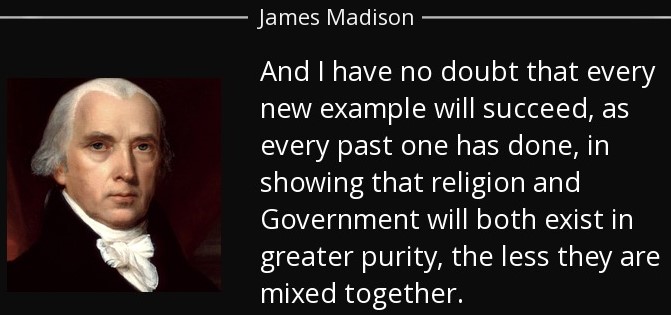
As I tell my students, religion is a major theme in the first part of my US history course because religion touched upon all aspects of American life. So many groups and individuals lived their lives according to what they believed to be God’s intentions for them in their Christian texts. Religion did indeed lead to violence and death, especially between colonists and Native Americans but among colonists, they avoided the warfare that affected Europe for so long.
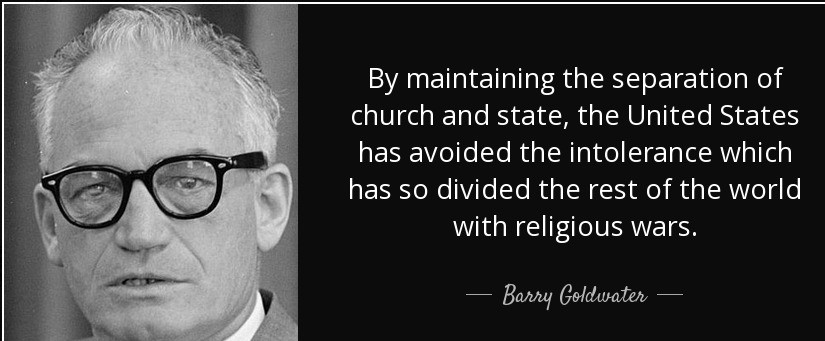
For example, the Puritans settled in Massachusetts and others need not apply, especially Catholics. Anglicans were the ruling religion in Virginia. Trinitarians were the norm. There were Presbyterians, arguably, Methodists, Episcopalians, Quakers, Congregationalists, and even Catholics, to name a few. And while some did indeed come here for religious reasons, the Pilgrims, Puritans, Anglicans, etc., did not come here for “religious freedom” as we know it, or as we used to know it, today.
Religion was used to promote intolerance. In Massachusetts, you would strictly adhere to the Puritan faith or face the wrath of the Puritan leaders. The same in Virginia and other colonies. While Quakers routinely settled in Rhode Island due to that colony’s “Open Door” policy, Quakers had to eventually sue Connecticut to overturn the law that prohibited them from settling there. I believe it was the intermittent governor John Winthrop Jr who was the Quaker’s attorney. I will have to find the citation for this. The same in Virginia: Only the beliefs of the Church of England would be tolerated or else punishment would follow. And to not be a Trinitarian was cause for death in many colonies: Jews, Muslims, and Unitarians could be killed if found openly living their religious lives. For example, Maryland’s Act of Religious Toleration protected all Trinitarians but sentenced to death anyone who refuted the divinity of Jesus, which would have been Jews, Muslims, and Unitarians. Many colonies’ religious toleration acts had the same penalty. People also had to honor the “Blessed Virgin Mary.” Something that Jews, Muslims and Unitarians would not do.[2]
One way to look at religion in the colonial era was that religion were used to promote intolerance. Today religion is used to promote intolerance while waving the flag of religious freedom. For example, some Christians do not support equal rights in marriage. In 2015 Kim Davis, a county clerk in Tennessee refused to give marriage licenses to same-sex couples “under God’s authority.” She ignored the ruling of several judges to include the US Supreme Court to issue those licenses and thus she was jailed for contempt of court.[3]. The same thing happened in New York in 2018 when Laurel Ericksen denied a marriage license to a same-sex couple allegedly on religious grounds. Governor Cuomo called the incident “an unconscionable act of discrimination.”[4]. But the most famous case was the one in Colorado where a baker named Jack Phillips refused to bake a wedding cake for a same-sex couple on religious grounds because baking the cake would give support to their wedding. The Supreme Court would eventually side with the baker but on very narrow grounds between him and a local magistrate. Hobby Lobby, a chain of hobby supply stores won a Supreme Court case that the owners did not have to carry insurance that provided birth control for its female employees on “sincerely held religious beliefs.”[5]
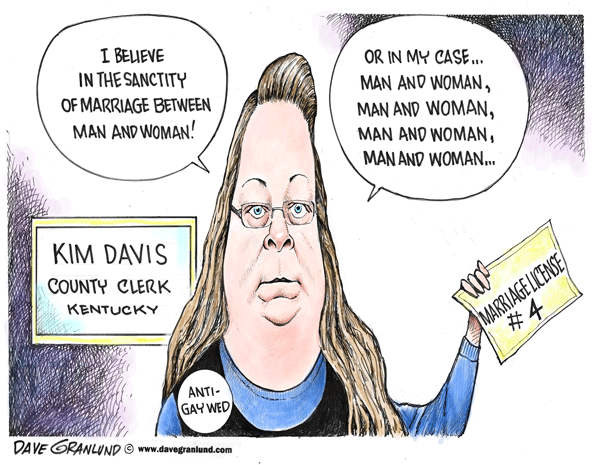
The big question is do these people live by all of God’s prohibitions or do they just cherry-pick this one? For example, besides the prohibition on homosexuality, the Old Testament prohibits so many things to include, but not limited to, the consumption of pork, eating meat and dairy in the same meal, tattoos, rounded haircuts (Leviticus), circumcision, going to psychics, wearing more than one type of textile at a time, children cursing at their parents (Hey parents, you’re supposed to kill them Exodus 21:17), staying married to a woman who was not a virgin before you married her (like the second, third, and fourth husbands of Kim Davis; actually the men are supposed to kill her, Deuteronomy 22:20-21), getting remarried after divorce, working on the Sabbath (penalty is death), and of course, masturbation is strictly prohibited. There are many other prohibitions in the Christian Bible such as the seven abominations in Proverbs and the 613 laws or commandments (not just 10). Do those people refuse to eat cheeseburgers because God prohibits that or are they just using religion to discriminate against homosexuals? Is religious intolerance in the 21st century similar to the 17th century? Sounds like a good research paper topic.
The positive aspects of the Maryland Act of Religious Toleration (1649) were that the leaders of Maryland were trying to stop the religious strife throughout Maryland between Catholics and Protestants that engulfed England at that time with Catholics supporting Parliament and Protestants supporting the monarch. The Catholics in Maryland failed to build their Wall and so Protestant immigrants came flooding across their borders. Catholic leaders feared both continued and worsening religious strife and being outnumbered by Protestants, hence the passage of the Act in 1649. Eric Foner explains the more salient features of the Act in this You Tube clip. Senator Barry Goldwater (R-AZ) established the Conservative movement. In 1964 he ran for president. In 1964 the US had been involved in the Vietnam conflict for 19 years. The first American died in Vietnam in 1945. He wanted to end the war and he was not against the use of tactical nuclear weapons. He also believed that the government had no business in your business and thus he believed in equal reproductive rights stating that the government should not be prohibiting women from getting abortions. His daughter had an abortion at a time when doing so was against the law. That medical procedure was between you and your doctor not between the government and your doctor. And abortion was illegal because religion and government were intertwined in that issue.

Limits on Religious Freedom[6]
Our understanding of religious freedom in the colonies must be tempered by our knowledge that religious freedom as we enjoy it today was by no means the norm in the American colonies of the 17th and 18th centuries. True, many groups and individuals came here to escape what they perceived as religious persecution in the old country, but depending on where they settled, the freedom they sought may have depended upon what form of religion they practiced.[7]
The Maryland Act on Religion, known as the Maryland Act of Religious Toleration of 1649, is held up as a model of the enlightened attitude in that colony. And while the act did indeed permit a wide degree of religious diversity within the realms of Trinitarian belief, the penalty for not believing in Trinitarianism was death. In other words, if you were a Christian who accepted the idea that God consisted of the Father, the Son, and the Holy Ghost, you were all right. But Trinitarian Christianity necessarily excluded Jews, Unitarians, and any other minor sects that did not see the Christian faith in exactly that light.
The Massachusetts Puritans certainly left England because they were being “hounded out of the realm” by King Charles I, but their own tolerance of religious dissenters both within and without their ranks was very limited indeed. Quakers who went to Massachusetts to spread their notion of the “inner light” were expelled from the colony, and when they returned, they were hanged. Dissenters such as Roger Williams and Anne Hutchinson and others were driven out of the colony in disgrace because they challenged Puritan doctrine. Furthermore, some of the offshoot colonies from Massachusetts Bay in Connecticut and New Hampshire were also generated by dissension within Puritan church congregations. Since the puritans’ only recourse for resolving disputes was the Bible, when they could not agree on what it meant or how it was to be interpreted, they divided.
During the 18th-century Virginia was distinctly unfriendly to anything but the Anglican religion. Under Virginia laws of the 1700s, preachers of other denominations were allowed to preach only under the most rigid structures, if at all, and people wishing to worship as Baptists, Puritans, or Catholics were distinctly unwelcome in Virginia up to the time of the revolution.
Although some colonies such as Pennsylvania and New Jersey were relatively open in inviting and accepting a diversity of religious believers, such circumstances tended to be the exception and not the rule. True religious freedom as we now understand it would have to wait for the revolution, and even then it took time for that to sink in, for the First Amendment to the Constitution guaranteeing religious freedom applied only to the federal government at the outset. The state governments, even after the Constitution was adopted, were still able to impose religious conditions for various forms of participation in public life.
Despite differences, the American colonists knew that religious wars had torn Europe apart from the time of the Reformation, including such bloody events as the Thirty Years War, the English Civil War, and the fights between Catholics and Protestants in France. All of those events convinced the colonials that if they brought their religious conflicts to America and allowed them to continue, their lives could become as full of bloody persecutions as those they had left behind. Gradually, therefore, a sense of religious harmony began to emerge, and although it was interrupted from time to time in the course of American history, as when the Irish Catholics began arriving in huge numbers in the 1800s. By the time of the War for Independence, Americans had decided that they wanted a life free of religious strife. Just as Roger Williams, a dissenter from the Massachusetts Bay Puritan colony, argued that the state had no right to dictate religious practice to its citizens, many more leaders such as Jefferson and Madison and others urged that a line of separation between church and state be established and made permanent, as it was in the First Amendment to the Constitution.
EXAMPLES
Certainly, there was a lack of religious toleration, as we would know it, in Massachusetts. On one hand, Puritans fled England because they were persecuted by the crown. On the other hand, when Quakers showed up they were expelled and some were even put to death upon their return. The Puritans wrestled with the way of getting to Heaven: good deeds or predestination. Those in the former lost. There were other controversies and those on the losing side of the arguments tended to be expelled from the colony such as Roger Williams and Anne Hutchinson. Dissenters formed Rhode Island, Connecticut, and New Hampshire. Anne Hutchinson eventually settled in New York (Brooklyn, I believe) where she was killed by Native Americans. Roger Williams established Rhode Island, nicknamed “the Sewer” by Puritans.
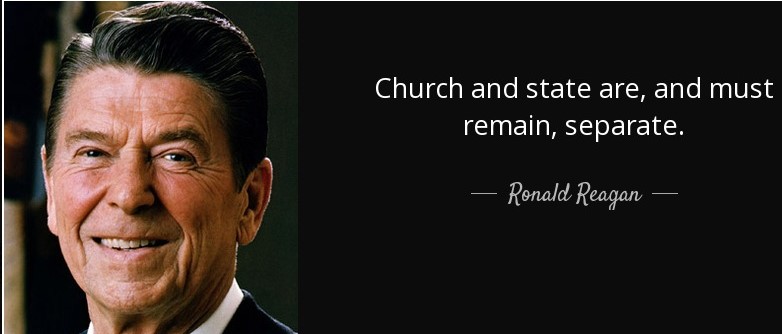
Virginia did not act as aggressively against non-Anglicans as Massachusetts (i.e. Virginia did not put to death non-believers), most fellow Christians were unwelcome in Virginia, especially Catholics, Puritans, and Baptists. Pennsylvania and New Jersey tended to follow the lead of Rhode Island in so much as they tolerated a diversity of religions. The basis of our idea of “religious freedom,” the First Amendment, was not around until the adoption of the Bill of Rights, which was December 15th, 1791. And initially, only the federal government could not impinge upon religion. States still could and they did such as imposing “religious conditions for various forms of participation in public life.”[8]
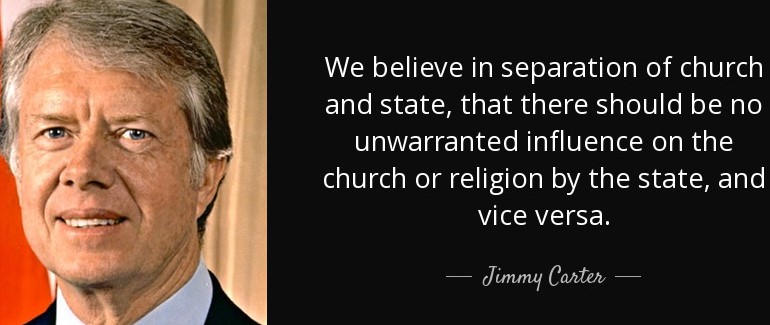
However, colonists were well aware of the long history of religious warfare in Europe stretching back to the crusades, the civil strife that followed the break up of the German Principalities at the onset of the Protestant Reformation, the massive and seemingly constant warfare among Protestant and between Protestant and Catholic nations and even the English Civil War. Although religious strife, conflict, agitation, revulsion, whatever you wish to call it, clearly existed in the colonies, so to did a desire not to repeat the European folly in the colonies. Anne Bradstreet’s (1612-1672) poetry tended to note that religion was a consolation, brought her peace, and something to relieve her worldly sadness or grief, not how religion was used as a weapon as seen in her own Massachusetts colony. Those First Great Awakening preachers’ carried the twin message of hope and salvation through religion. And, Revolutionary leaders will use the ideas of such itinerant preachers like Jonathan Edwards as we get closer to 1776. “Harmony” was a word used often to describe the type of existence the various religions should have in the colonies. Roger Williams in Rhode Island may have been the first to argue the state needed to stay out of the practice of supporting one religion, but the idea spread and leaders of the American War for Independence carried the baton to the finish line. The words and ideas of John Adams, Thomas Jefferson (through John Locke), James Madison, to name a few, found their way into the First Amendment. Jefferson got Virginia out of the religion business when, in 1779 he introduced the Virginia Statute of Religious Freedom prohibiting the state from supporting one religion over all others in order to protect “the Jew, the Gentile, the Christian, the Mahometan, the Hindoo, and [the] infidel of every denomination.”[9]Jefferson’s bill was passed in 1786 and influenced Jefferson’s protege, James Madison. Americans will be wary of Catholics to the extent that when a Catholic ran for President in 1960, John F. Kennedy, toured the country giving a speech that assured Americans that he will follow the Constitution, not the dictates of the Pope. Interestingly enough, in 2017 some Republicans sought to allow members of the clergy to be able to campaign from the pulpit. They wanted to tear down the wall that separates church and State.[10][11] But in 1960 then-candidate for President Senator John F. Kennedy supported the separation of Church and State.
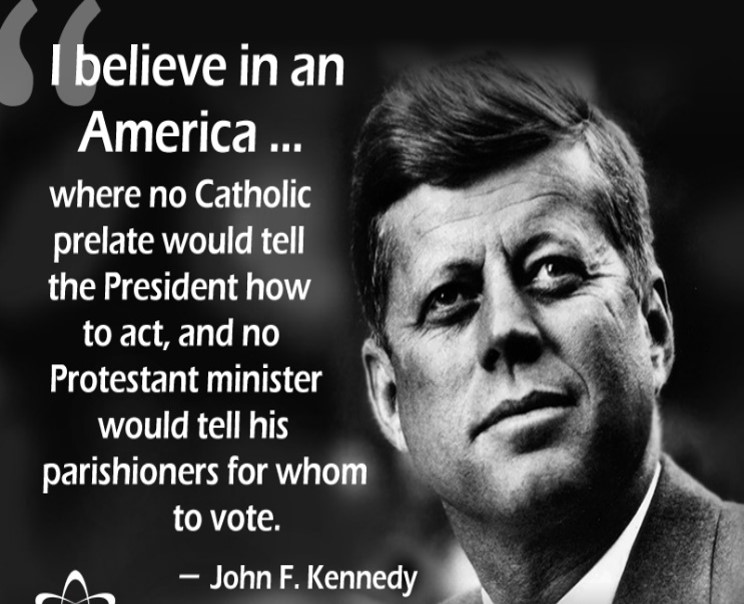
The American War for Independence is sandwiched between two waves of religious revivalism that we will call the First Great Awakening (the early 1700s) and the Second Great Awakening (early 1800s). In the precursor to the First Great Awakening, people had been leaving the established churches. George Whitefield was hired by some of the established religious elite to tour the area, give sermons, and do what he could to get the lost sheep back to rejoin the flock. He was not terribly successful and so the religious elite hired Jonathan Edwards. Edwards was more dramatic. Wherever he went massive crowds appeared. The message that people took away was that they did not need a minister in order to be told how to lead a good Christian life. They did not need to even belong to a church in order to be saved. The phrase “born again” entered the American lexicon as a result of the First Great Awakening. The purpose of the First Great Awakening was to get the people to return to the established churches. The result was the opposite. There was, for example, the establishment of the Baptists, and the growth of the Unitarians, Universalists, Methodists, and Episcopalians. Instead of returning to the Church of England, people left the Church of England to either create uniquely American churches or just to leave traditional churches themselves. The first step in the Revolution is to break away from the Church of England. The next step is to break away from England itself. The First Great Awakening was revolutionary.
But what so many fought and died for might be coming to an end as more people who claim the mantle of Conservative (certainly not the Conservative established by Sen. Barry Goldwater) want the government and religion, particularly one religion, to work together. Jerry Falwell, who died in 2007, was a Baptist minister who spoke out against civil right in other words he supported inequality between blacks and whites, between men and women, etc), denounced Martin Luther King Jr, and the desegregation of schools -so he supported having white schools only. Falwell founded the Moral Majority when, in the early 1970s, the IRS stipped Christian schools which prohibited interracial dating of their tax-exempt status. Falwell did not like black people and white people dating and thought the government should stay out of his business of forcing black and white people from dating at his and other Baptist ministers’ schools. He wanted to get rid of all public schools -the church would take over running all schools and America’s children would be taught religious education, not public education. He blamed a long list of groups for 9/11 (except Muslim terrorists) to include the LGBT community.[12] Not surprisingly, Jerry Falwell, the Baptist minister, televangelist, megachurch owner, and leader of Liberty University, was not a supporter of the separation of church and state.
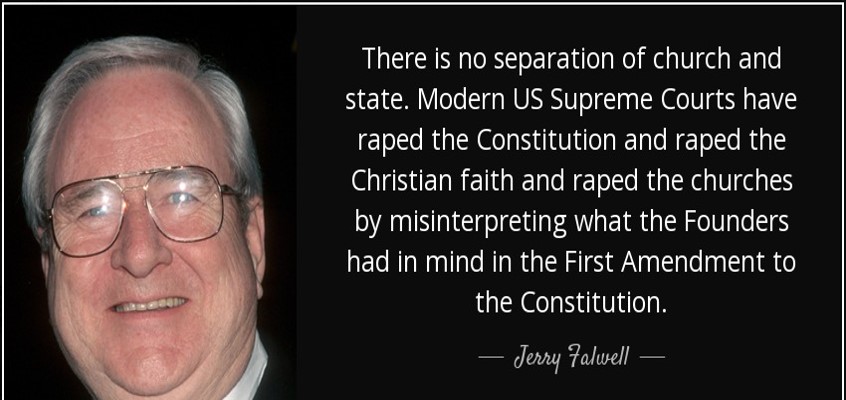
So let’s review what the guy who wrote the First Amendment (aka “Father of the Constitution”) had to say about the separation of Church and State. James Madison wrote in a letter to Edward Livingston in 1822 “religion and government will both exist in greater purity the less they are mixed together.”[13] Senator Rick Santorum from Pennsylvania, who called himself a Conservative but certainly not part of the Conservative movement launched by Sen. Barry Goldwater, seemed to have been supporting the ideas of Congress and the White House of 2017 when Santorum (a Catholic) said in 2012 about Kennedy’s speech of 1960 when Kennedy (a Catholic) reiterated his support for the separation of Church and State. Santorum said: “You bet that makes me want to throw up.”[14]
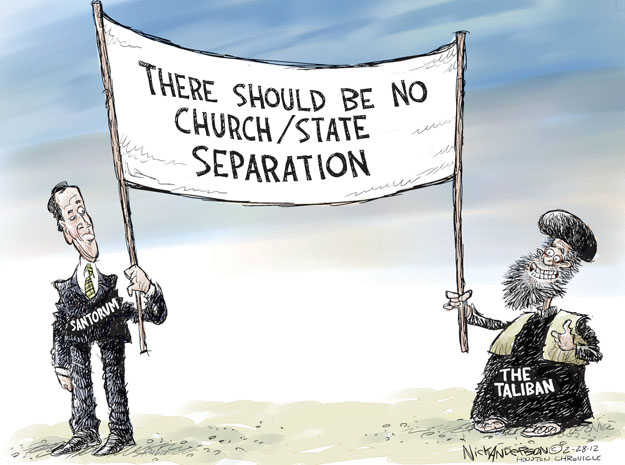
Is this editorial cartoonist from the Houston Chronicle saying there is no difference between an ultra-conservative Christian who wants no light between church and state and an ultra-conservative Muslim group who does rule with no light between church and state? They both want the same thing. They both want their religion to be thrust upon everyone. They want everyone to be forced to live by their religious beliefs, standards, and requirements.
John Adams said something like “War is easy. Revolution is hard.” American colonists did not fight the War for Independence for religious reasons. It was not a war for religious independence. Patrick Henry wrote the intellectual lynchpin –Common Sense. They were not going to fight for taxes or any selfish, self-centered reasons but to protect and save 1,000 years of British history, law, and freedoms for the world. England had turned its back on British culture, It was up to Americans to preserve British civilization. That’s why they went to war. Patrick Henry wrote a few other things about George III, but the crux of the thesis of Common Sense was that the war was to fulfill Winthrop’s call for the creation of that City upon a Hill. To start the process of the creation of that beacon of hope. That’s going to be the Revolution. The hard part. Millions come to the US. More than any other country, the US is the place where people want to come to. This may not be the City upon a Hill but this is a beacon of hope and for most, not for religious reasons: employment is the number one reason why people come to the US and the most immigrants come to the US from Mexico, then China, India, the Philippines, and El Salvador. There were nearly 9 million people difference between the first and second countries of origin. By region, however, South and East Asia combined for 27% of all immigrants, which equaled Mexico. Since 1980, when the US created a federal refugee resettlement program, the US has taken in more refugees than any other country. Regarding work, ” Immigrants, regardless of legal status, work in a variety of jobs and do not make up the majority of workers in any U.S. industry. Lawful immigrants are most likely to work in professional, management, or business and finance jobs (38%) or service jobs (21%). Unauthorized immigrants, by contrast, are most likely to be working in service (31%) or construction jobs (17%).”[15] Nowhere in the Pew Research Center’s report is religion a significant reason for immigration to the US. Nevertheless, this is the place to be. A print that Jefferson and Madison would have agreed with, although neither would have recognized the building on the right.
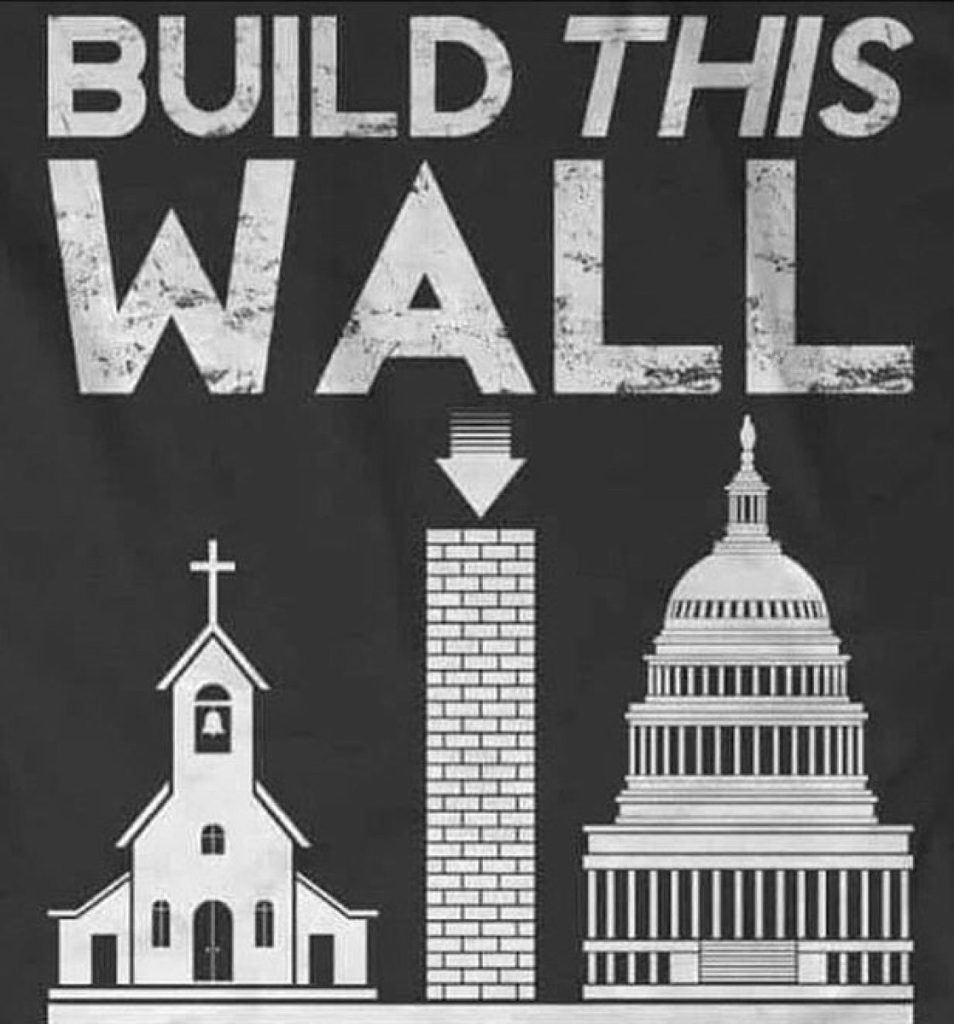
As with the other chapters, I have no doubt that this chapter contains inaccuracies. Please point them out to me so that I may make this chapter better. I am looking for contributors so if you are interested in adding anything at all, please contact me at james.rossnazzal@hccs.edu.
- https://www.worldhistory.biz/modern-history/82863-religion-and-early-american-history.html ↵
- https://www.encyclopedia.com/history/dictionaries-thesauruses-pictures-and-press-releases/act-concerning-religion-1649 ↵
- https://en.wikipedia.org/wiki/Kim_Davis ↵
- https://www.nytimes.com/2018/08/02/nyregion/cuomo-same-sex-marriage-clerk.html ↵
- https://apha.org/~/media/files/pdf/topics/aca/hobbylobbyfactsheet.ashx ↵
- I cannot recall if I authored or edited this section. I cannot find where this originated if I did not author this section. ↵
- This paragraph does not sound like me. But it is well written so I am leaving it as is. ↵
- https://www.worldhistory.biz/modern-history/82863-religion-and-early-american-history.html ↵
- https://mtsu.edu/first-amendment/article/880/virginia-statute-for-religious-freedom ↵
- https://www.washingtonpost.com/politics/trump-signs-order-aimed-at-allowing-churches-to-engage-in-more-political-activity/2017/05/04/024ed7c2-30d3-11e7-9534-00e4656c22aa_story.html?noredirect=on&utm_term=.1482da9b497c ↵
- https://www.washingtonpost.com/news/acts-of-faith/wp/2017/11/02/the-republicans-tax-bill-would-let-ministers-endorse-political-candidates/?utm_term=.8fd6386bbf28 ↵
- https://en.wikipedia.org/wiki/Jerry_Falwell ↵
- http://press-pubs.uchicago.edu/founders/documents/amendI_religions66.html ↵
- https://www.politico.com/blogs/politico-now/2012/02/santorum-jfk-speech-makes-me-want-to-throw-up-115569 ↵
- http://www.pewresearch.org/fact-tank/2018/11/30/key-findings-about-u-s-immigrants/ ↵
